From Double Indemnity (1944) to Sweet Smell of Success (1957), here are the best film noirs of all time.
The term ‘film noir’ was originally coined by French film critic Nino Frank in 1946. Now, cinephiles are well aware that noir emerged alongside the anxieties of the World War II era. Though some may argue that it’s a genre, others choose to call it a style or mood. Whatever the case, film noir originated matter-of-factly and went on to have a lasting impact on cinematic storytelling. Critics and scholars cite film noir as a synergy of various American movie tropes. Noir plotting has a lot in common with gangster films of the Great Depression and Prohibition era.
The next big influence was American hard-boiled detective fiction of the 1920s and 1930s. Raymond Chandler, Dashiell Hammett, and James M. Cain were prominent authors of this genre. Their cynical and oddly poetic tone shaped the mood of film noir. The third and most important influence was the influx of expat filmmakers who fled away from Nazi rule. Fritz Lang, Billy Wilder, Robert Siodmak, Otto Preminger, and Michael Curtiz — all outsiders to the Hollywood studio system — have greatly contributed to noir films.
These filmmakers used slanted camera angles and shadowy sets of German expressionism to define the bold visual design of film noir. And how can we forget to use the word ‘chiaroscuro’ while discussing the stylistic visual elements of film noir? An Italian word for light-dark, chiaroscuro is a form of studio lighting that would cast bright lights and sharp shadows on the sets. It was essential to use such lighting techniques due to budgetary constraints. But the expressionist use of shadow and light created a particular mood that pushed us closer to the noir characters’ moral universe.
Noir films are indeed a vast subject. From their doomed anti-heroes to enticing femme fatales, noir tropes including their characters, and their socioeconomic environment, these films continue to incite heated conversations. Besides, even the parameters of defining film noir and its period are up for discourse.
For the below list, I’ve taken into account film noirs set in America, made between 1941 and 1958. In other words, from Huston’s Maltese Falcon to Welles’ Touch of Evil. Some of my favorite film noirs are from the 1970s (The Long Goodbye, Chinatown, Night Moves, etc). Yet to draw some line despite the genre’s ambiguity, I’ve set such parameters. Quickly then, let’s dive into some of the best film noirs of all time.
Best Film Noirs of All Time
25. Ride the Pink Horse (1947)
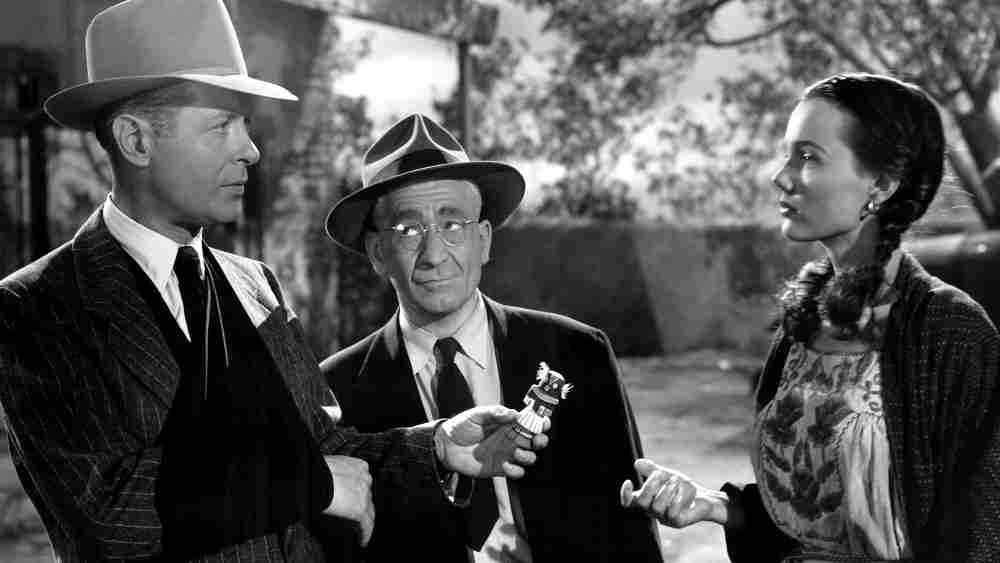
Film noir movies are often associated with urban spaces like New York and L.A. But many classic noir films are set in rural and small-town spaces. Case in point, Robert Montgomery’s nuanced noir unfolds in the New Mexico border town of San Pablo. Montgomery was a popular actor who made his directorial debut with Lady in the Lake, an adaptation of Raymond Chandler’s novel.
His second directorial effort, Ride in the Pink Horse was more offbeat and perfectly tapped into the atmospheric beauty of film noirs. The film was based on Dorothy B. Hughes’s novel of the same name. Montgomery plays a mysterious tough guy named Gagin who arrives in San Pablo. The town is getting ready for a fiesta while Gagin looks for a shady and equally mysterious Frank Hugo. The classic film noir deals with the themes of post-war malaise and disillusionment.
24. They Live By Night (1948)

Couples-on-the-run is one of the staple storylines in Hollywood. Fritz Lang’s second American film, You Only Live Once featured Henry Fonda and Sylvia Sidney as they run away from an inescapable past. Nicholas Ray’s debut feature also dealt with a similar plotline. A boy-meets-girl love story, criminal element, and fatalistic philosophy are the familiar parts of it. Yet the gorgeous landscape photography, shadow-laden lighting, and a mesmerizingly tender performance by Cathy O’Donnell never turn the tale into a sappy melodrama.
Nicholas Ray went on to revolutionize Hollywood aesthetics with diverse works like Johnny Guitar, Rebel Without a Cause, etc. The filmmaker was greatly admired by French New Wave filmmakers. In fact, the impact of They Live by Night could be seen in Godard’s Breathless and Pierrot le Fou. Moreover, ‘Lovers on the Run’ films are a tool for social criticism that continues to appeal to our collective imagination. Bonnie and Clyde, Badlands, True Romance, and Wild at Heart are some interesting examples.
23. Gun Crazy (1950)
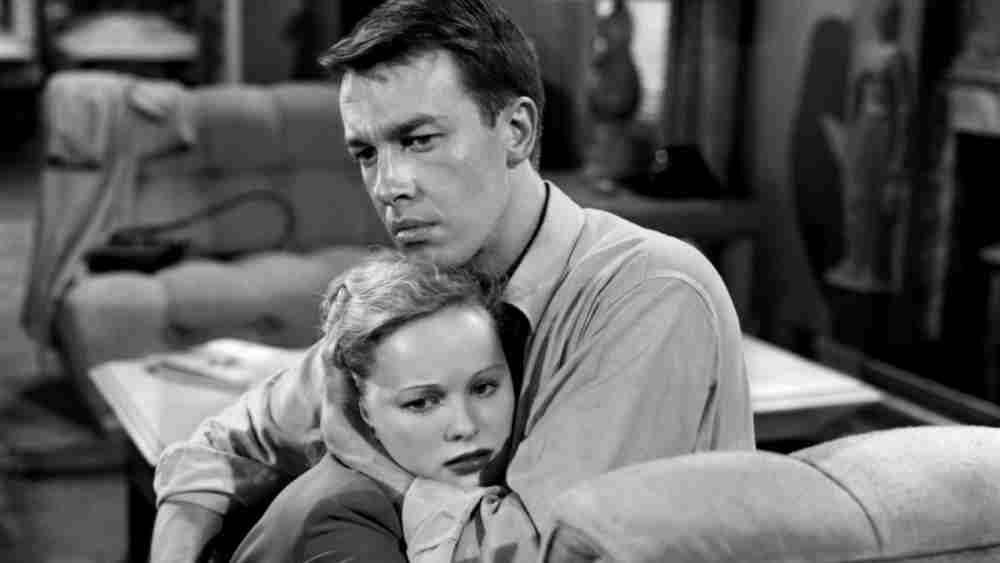
Similar to They Live By Night, Gun Crazy is a tale of lovers on the run. But the similarities between both noir films end there. Joseph Lewis’ narrative moves at a breakneck pace and doesn’t have the polished aesthetics and elaborate mise-en-scène of Nicholas Ray. Made on a very low budget, Lewis creates some astounding set-pieces including a bank robbery scene. Apart from fatalism, one of the perennial themes of film noir is obsession. In Gun Crazy, Anne and Bart love guns and are obsessed with taking a shortcut to achieve the ‘American Dream’.
Anne was played by the alluring Peggy Cummins. And the film belongs to Cummins whose shrewd femme fatale is one of the most badass characters in noir films. The narrative does flirt a bit with misogyny, and it overtly glamorizes criminal life. Yet its raw visual energy and pulpy sensibilities offer a rollercoaster ride.
22. Thieves’ Highway (1949)
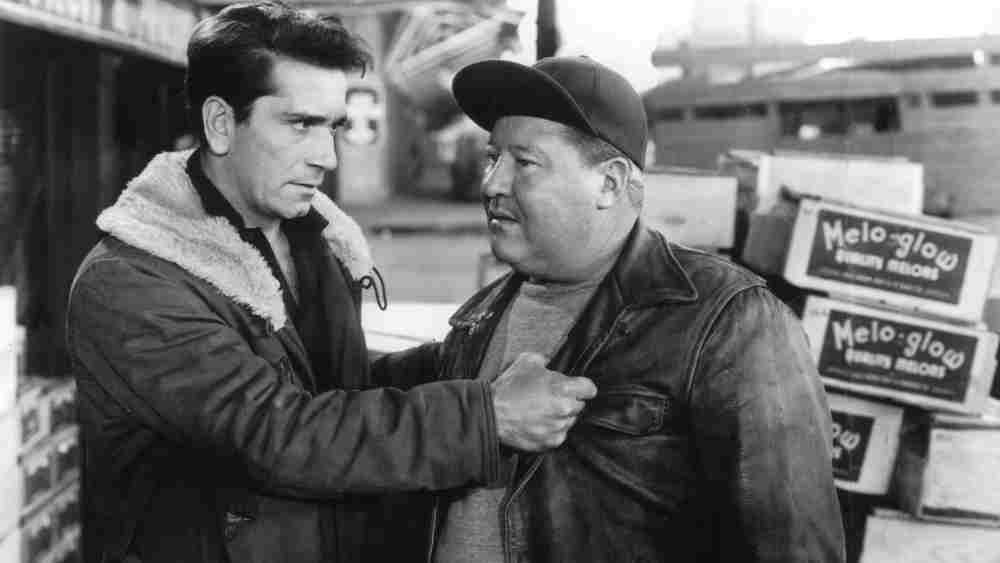
Jules Dassin has made some amazing film noir classics. Brute Force (1947) and The Naked City (1948) established him as a prominent American auteur. He was also a victim of the infamous Hollywood Blacklist. This pushed him to move to Europe and work there for nearly three decades. He made the classic London noir Night and the City (1950) and the French crime masterpiece Rififi (1955). Yet my favorite among Dassin’s filmography is Thieves’ Highway, a fervent critique of Capitalism.
Made before Clouzot’s Wages of Fear, Thieves’ Highway is set in the dog-eat-dog world of truckers. The film opens with war veteran Nick returning home. He is happy to reunite with his family and marry his sweetheart. However, grave news awaits him at home. Nick’s trucker father has lost his legs and is swindled by a shady market dealer. Subsequently, Nick receives a tempting offer to get back his father’s truck. Thieves Highway is recognized by the idiosyncratic term ‘film gris’. It denotes film noir movies with a leftist criticism of American society, which came under the scrutiny of the House Un-American Activities Committee (HUAC).
21. Detour (1945)
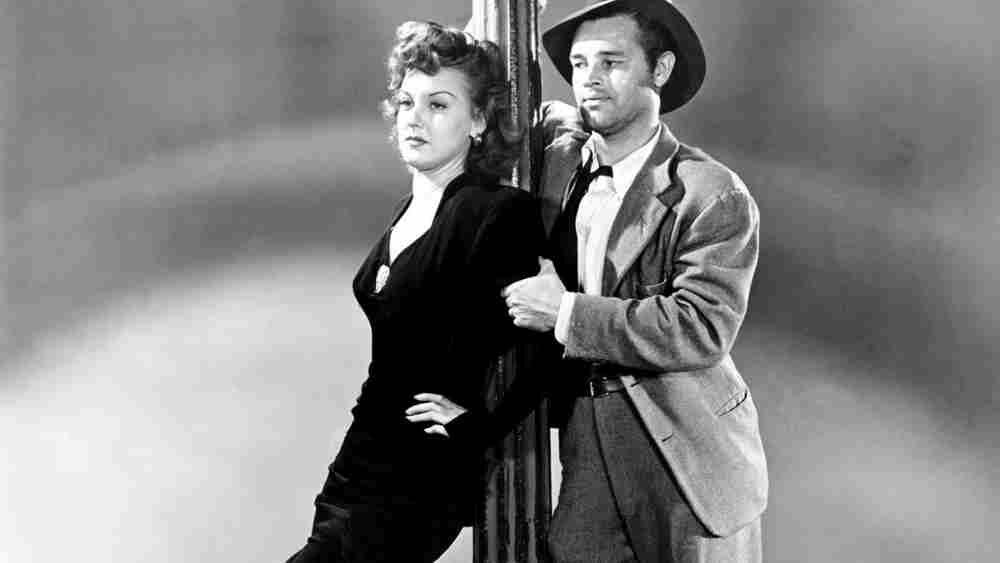
In his 4-star review of Detour, Roger Ebert calls it, “haunting and creepy, an embodiment of the guilty soul of film noir. No one who has seen it has easily forgotten it.” There were plenty of transient B-movie studios that kept popping up in Hollywood between the 1930s and 1950s. These studios were addressed by the slang term ‘Poverty Row’. These films roughly imitated an existing trend, turning it pulpier to make some quick money. Nevertheless, many of the now-revered film noir movies are made by ‘poverty row’ studios.
Detour was shot in 28 days with unbelievably minimal resources. It revolves around a loser protagonist named Al Roberts whose tough luck follows him while hitchhiking his way to California. The broken man meets a dangerous woman. The ensuing conflict is staged in a spellbinding atmosphere, filled with effective lighting and unusual camera angles. Detour was directed by Edgar G. Ulmer, an Austrian expatriate who worked as a set designer in some of the influential German expressionist movies.
20. Nightmare Alley (1947)
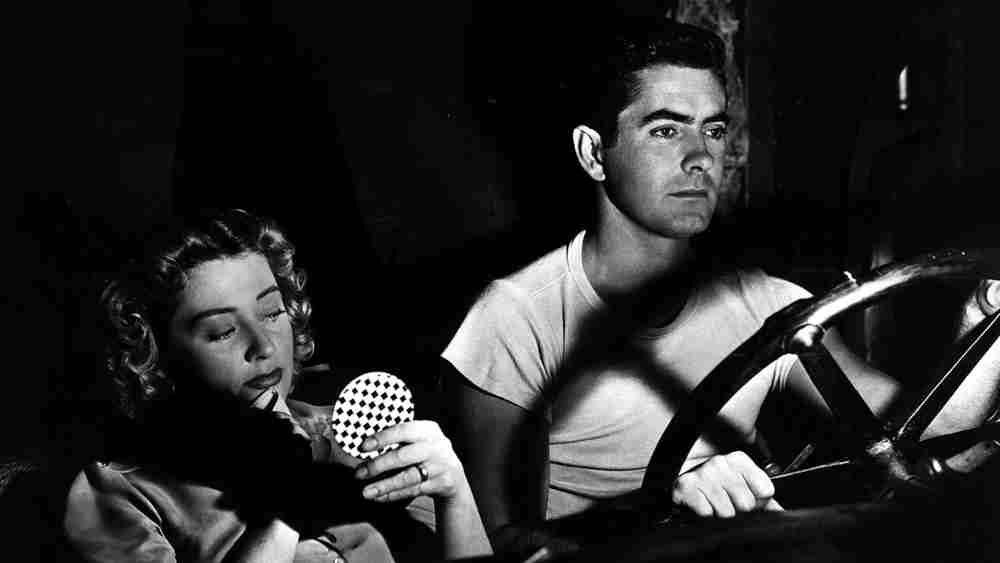
Edmund Goulding’s rediscovered and strange film noir is marked by the absence of guns, cops, and gangsters. Yet it’s riddled with cynicism, double-crosses, dark mind games, and seductive chiaroscuro lighting. The film revolves around a traveling carnival. Tyrone Power brilliantly plays the ambitious hustler, Stanton Carlisle who learns the tricks of the trade by associating himself with a mentalist named Zeena (Joan Blondell). On learning the tricks, he uses deception to enter into the high society. What follows is his inevitable downfall and ruin.
Nightmare Alley was based on William Lindsay Gresham’s novel. Tyrone Power himself brought the rights to the novel and put together the project. Hollywood heartthrob Tyrone is at his finest as Stanton. The narrative deals with showmanship and charlatans, not the typical criminal enterprise we encounter in film noir. But its indelibly bleak worldview and assessment of humanity make it an influential work in the noir canon.
19. The Asphalt Jungle (1950)

John Huston’s hard-boiled film noir set the template for heist movies. Its stark visuals, snappy dialogues, and rough-hewn characters got deeply ingrained in urban noir films. Based on W.R. Burnett’s novel, Asphalt Jungle follows a crew of men planning a jewelry heist. A team of small-time criminals comes together to work for a criminal genius. The meticulously executed job eventually leads to disaster as greed, obsession, and foolishness take over.
John Huston is well-known for his framing techniques and unusual camera angles. His remarkable mise-en-scène brings a remarkable tone to the conventional noir set-up in the latter half. In fact, the film’s stylistic elements are so widely appropriated that it would be hard to appreciate the originality of the imagery here. Asphalt Jungle also marks Marilyn Monroe’s first substantial role.
18. Murder, My Sweet (1944)
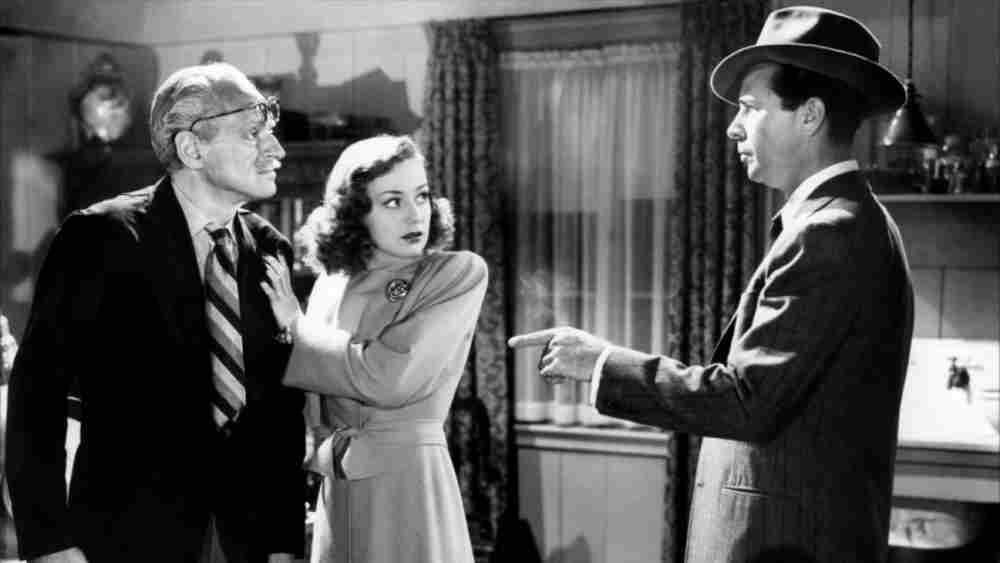
Private eye Philip Marlowe was an impressive creation of Raymond Chandler’s hardboiled fiction. Marlowe isn’t ideal hero material, but rather defined by his disillusionment and cynicism. Edward Dmytryk’s Murder, My Sweet marks the first big-screen adaptation of Chandler’s Marlowe series. Dick Powell plays the central character, who gets hired by an ex-con, freshly released from jail. The man wants to find his missing girlfriend.
Chandler’s tales are exasperatingly convoluted and dark. Though the convoluted plotting makes it hard work to follow, Dmytryk’s elaborately stylized scenes exude film noir atmospherics. The first-person narration — a staple element of noir — is absolutely spellbinding. My favorite on-screen Marlowe actors are Humphrey Bogart and Elliott Gould. Nevertheless, Powell gets to the essence of the character — a romantic at heart with a cynical exterior. Besides, the role was a welcome change for Powell since he is best known for musicals.
17. The Killing (1956)
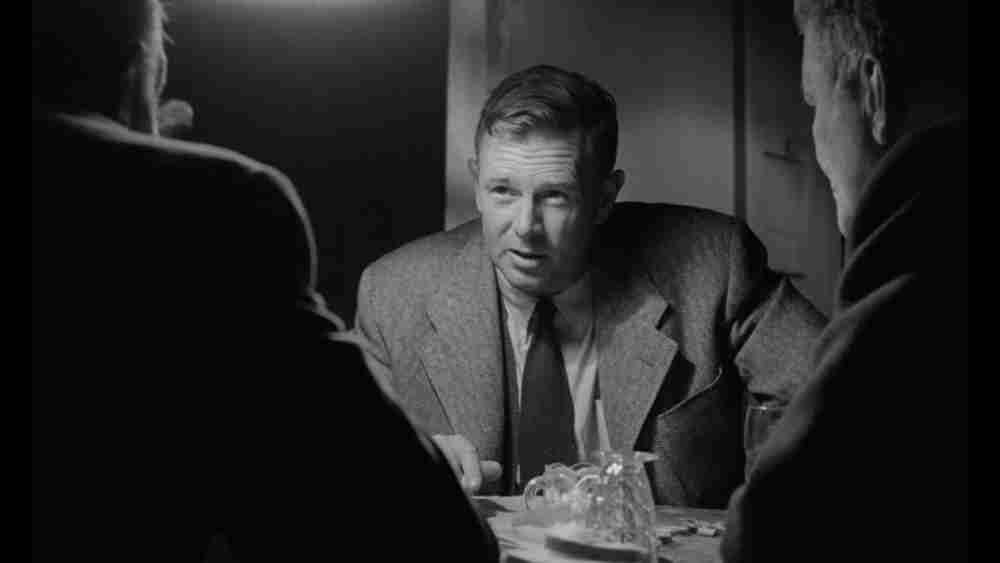
Sterling Hayden is cinema’s renowned tough-guy hero. His reputation was cemented by his morally nuanced roles in Asphalt Jungle and Johnny Guitar. When Hayden read the script for The Killing he immediately wanted to be part of it. The actor was more intrigued when he heard the director is a rookie named Stanley Kubrick. Kubrick had made two independent features before The Killing. Hence, he was a complete outsider to the studio system although the studio execs already perceived him as a budding genius.
Though a taut and pretty straightforward caper film, The Killing proved Kubrick’s supreme directorial skills. The narrative is based on a crime novel by Lionel White. It revolves around a gang of men trying to pull off an audacious heist on a racetrack. The film features signature noir elements like chiaroscuro lighting and claustrophobic interiors. But its elegant tracking shots and unique compositions foreshadow the awesome Kubrick moments.
The film has its share of flaws, particularly the flat characterizations. The Killing, unfortunately, didn’t do well at the box office. Yet Kubrick’s talent caught the attention of Hollywood star Kirk Douglas.
16. The Lady From Shanghai (1947)

Orson Welles could be one of the most idealized filmmakers. At 23, he created a sensational radio play based on H.G. Wells’ The War of the Worlds. When he was 25, he made Citizen Kane, often cited as one of the finest in film history. But even in the early part of his career, Welles had to constantly fight with producers and studio execs over creative control of his projects. His tough luck with the producers continued with The Lady From Shanghai.
The narrative has a familiar pulpy noir template. Welles plays an Irish rogue who falls for a beautiful woman (Rita Hayworth). He discovers that she’s married, and yet takes a job on her yacht. What follows is a convoluted set-up for murder. The Lady From Shanghai was one of the location-shot noirs which are full of innovative cinematography. Despite Welles’ failing marriage with Rita Hayworth in real life, the couple shares a compelling on-screen chemistry. The film’s running time is around 90 minutes whereas the Welles’ original cut was an hour longer. It makes the film very uneven. Yet The Lady From Shanghai is one of Welles’ entertaining studio films.
15. White Heat (1949)

Post-war noir aesthetics was mixed with 1930s gangster stories in Raoul Walsh’s explosive drama. Most of the ‘30s gangster films withheld sympathy for their bad-boy protagonists. But James Cagney’s Cody Jarrett in White Heat is portrayed as a complete psychopath. Cagney himself was best known for his charming turn in gangster films like Public Enemy and Angels with Dirty Faces. However, his delightful performance in Michael Curtiz’s musical Yankee Doodle Dandy changed his image as a tough guy. Hence Cagney’s decision to once again play a homicidal thug with more vigour and panache is intriguing.
An old-school Hollywood director, Walsh entered into filmmaking in the silent era. Hence, it’s fascinating to see him embed some of the formalist elements of film noir. His formalist noir techniques are apparent in White Heat’s night-time scenes. But the most iconic noir imagery in the film is the incendiary final scene when Cody, confronting his imminent death, screams “Made it Ma! Top of the World!”
14. Mildred Pierce (1945)

The portrayal of women in classic film noir often falls into simple categories. Michael Curtiz’ Mildred Pierce is one of the rare film noirs to feature a complex heroine. The fantastic Joan Crawford plays the assertive yet flawed eponymous protagonist. Based on James Cain’s 1941 novel, the film opens like a murder mystery. Gunshots reverberate as a man is killed, and his dying words are ‘Mildred’. In flashbacks, we learn about the entrepreneurial Mildred who tries to support her family during the Great Depression. Eventually, she’s undone by the greed of other people.
Despite acquiescing to some of the noir trappings, Mildred Pierce is a fine character study. In terms of style and tone, Michael Curtiz perfectly balances noir aesthetics and melodrama. Crawford received an Oscar for her iconic role, which re-launched her career.
Todd Haynes’ adapted Cain’s novel for a miniseries in 2011. Kate Winslet did a phenomenal job in playing the titular character.
13. Scarlet Street (1945)
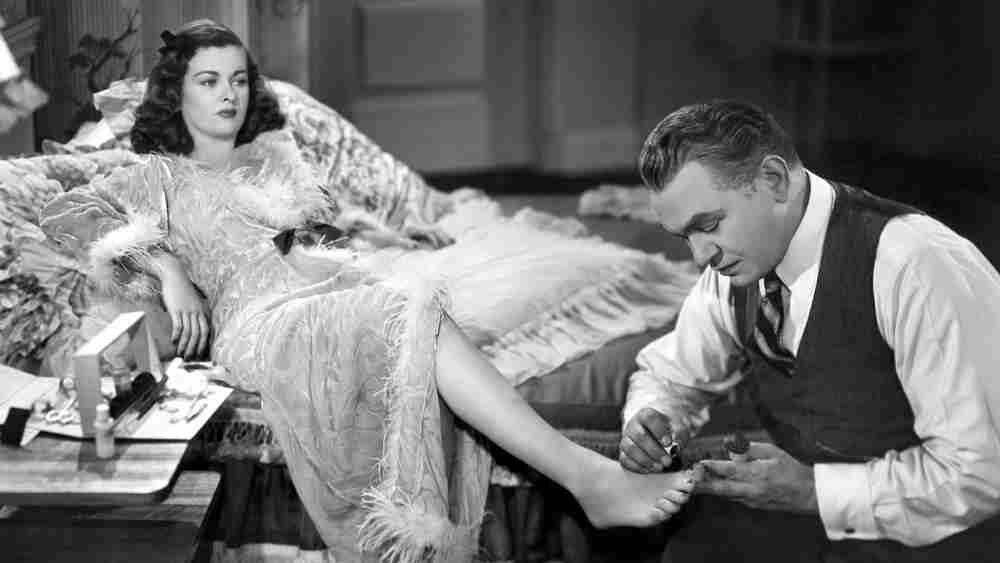
Edward G. Robinson’s Christopher Cross in Lang’s Scarlet Street is a unique protagonist in the noir universe. He is neither a cynical detective nor a low-level criminal. Cross is a middle-aged everyman who has worked decades as a cashier. Estranged from his wife, he doesn’t have many possessions in life. One day he rescues a young woman Kitty from her abusive boyfriend. Cross’ noble intentions, however, gradually ruin him.
Scarlet Street is based on a novel called La Chienne (The Bitch) which was already adapted by Jean Renoir. While Renoir treated his film as a black comedy, Lang turned it into a brilliant tale of paranoia. The narrative’s noirish element heightens when Cross understands the cruel manipulation he was subjected to and attempts to stand up for himself.
Along with Jules Dassin and Robert Siodmak, Lang’s contribution to film noir aesthetics is commendable. Though Lang’s Scarlet Street and Woman in the Window had an unconventional noir plot, his high stylizations became an integral part of noir imagery.
12. Kiss Me Deadly (1955)

Robert Aldrich’s Kiss Me Deadly is based on a Mickey Spillane novel, featuring private eye character Mike Hammer. The narrative sets out with Hammer picking up a young hitchhiking woman. Soon, he’s beaten unconscious, and the woman is tortured to death. Hammer wants to get to the bottom of this despite the warnings. The trail leads him to a mysterious box.
Kiss Me Deadly incorporates Cold War nuclear bomb paranoia into the noir template. Though the narrative contains a very unique MacGuffin, the characters and thematic concerns are very much within the boundaries of film noir. Working with ace cinematographer Ernest Laszlo, Aldrich creates stupendous imagery despite the ultra-low budget. The Pandora’s box at the narrative’s center can’t be taken seriously from a scientific perspective. Yet it remains a potent symbol of the Atomic age and its related paranoia. Quentin Tarantino paid homage to the film’s symbolic element in Pulp Fiction.
11. The Killers (1946)
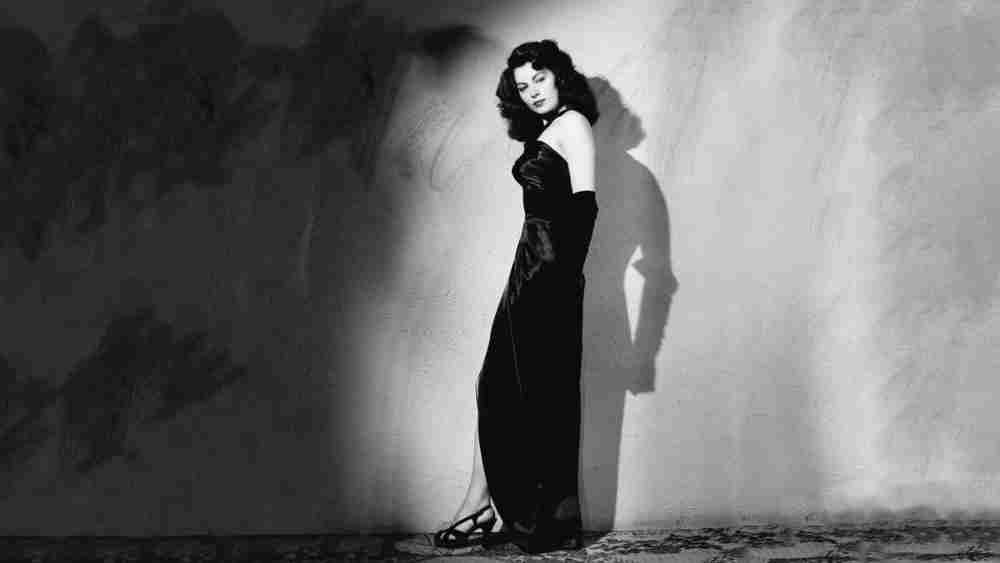
Director Robert Siodmak, a German émigré, made some of the landmark noir films including The Killers, The Spiral Staircase (1945), and Criss Cross (1949). He is one of the filmmakers to blend the claustrophobia of German expressionism into noir film aesthetics. In fact, most Siodmak films were shot inside studios; his mise-en-scène and lighting effects are meticulously planned. The Killers is based on a 1927 Ernest Hemingway short story. The 10-page story was brilliantly adapted by Anthony Veiller who turned it into a perfect fit for noir film mystery.
The narrative largely unfolds in flashbacks, and intriguingly opens with the murder of its protagonist (Burt Lancaster). Lancaster plays a prize-winning boxer whose injury pushes him to a life of crime. Almost all of the characters in the narrative are ambiguous although a sense of existential doom looms over them. The brooding atmosphere of Siodmak made critics call it ‘Citizen Kane of noir’. There are a lot of invigorating set pieces. The most memorable is the swooping crane shot as Siodmak films a heist sequence supposedly in a single take.
10. Gilda (1946)
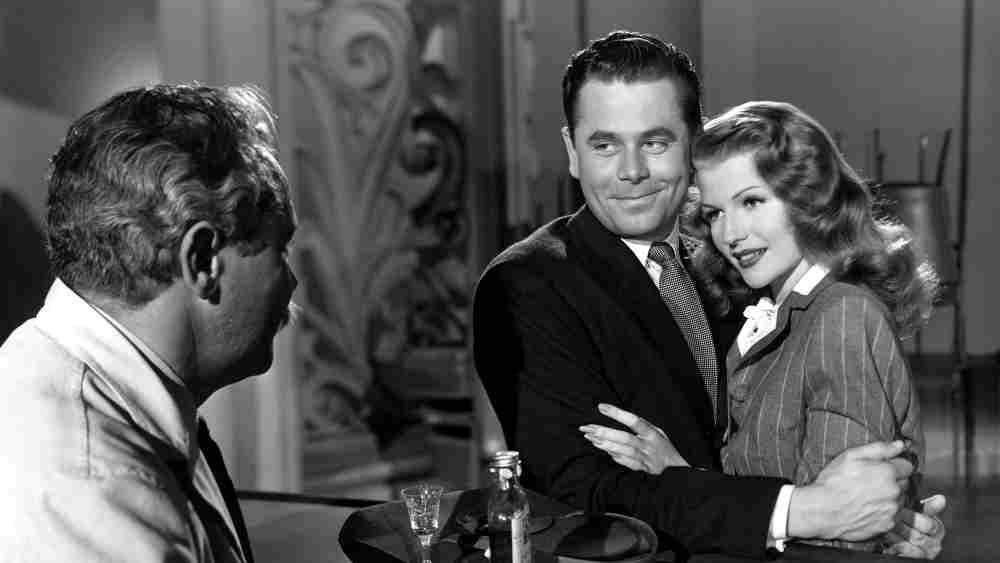
Charles Vidor’s noirish romance drama is best known for Rita Hayworth’s indelible performance. From the first glimpse of Gilda with that iconic hair flip, the impact of Hayworth’s character on Hollywood cinema is huge. The narrative revolves around a tense love triangle between Gilda, her husband, and the man hired to manage the husband’s casino.
Gilda, however, isn’t a typical femme fatale of noir cinema. There’s a sense of foreboding in the narrative, but never extreme violence. The film is rather loaded with sexual innuendos and even homoeroticism. Vidor skilfully managed to circumvent the censorship rules – dubbed ‘Hays Code’ – of the time.
Gilda is one of the well-fleshed-out female characters in noir films. She is portrayed as a complicated individual. Beneath the vivacious exterior lies pain, disappointments, and contempt. Hayworth perfectly realizes the character’s emotional complexities. From the contemporary perspective, the film’s sexual metaphors look problematic. Yet, it is a fascinatingly dark exploration of love and obsession.
9. The Maltese Falcon (1941)
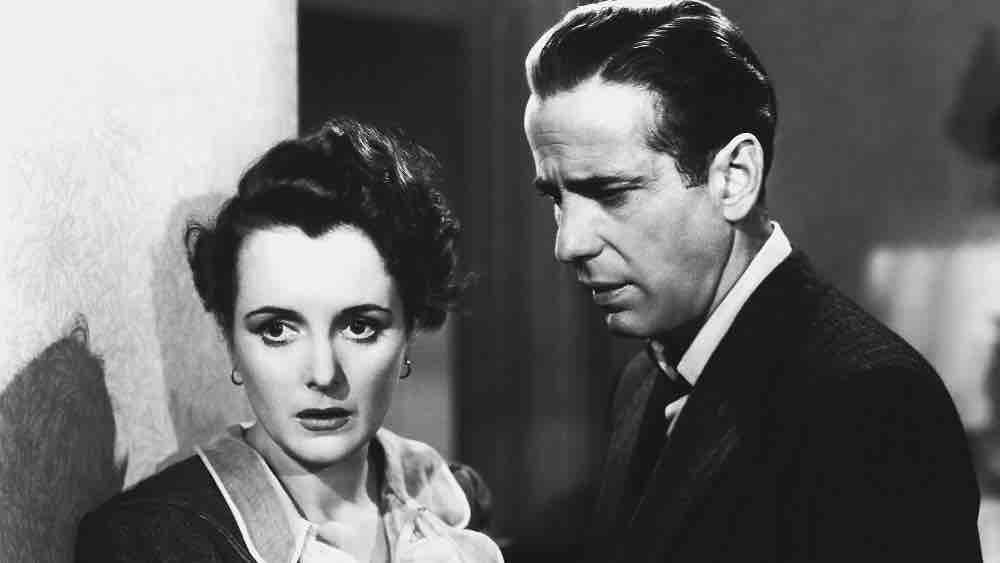
John Huston entered the Hollywood industry as a screenwriter. His script for Howard Hawks’ Sergeant York and Raoul Walsh’s High Sierra were huge hits. Therefore, he approached Warners – for whom he worked – to get a chance in direction. It was said that Jack Warner gave Huston a project of his own choosing. Huston opted to adapt Dashiell Hammett’s 1930 novel The Maltese Falcon. Critics call it the earliest film to carry the noir staples. The major themes, visual techniques, characterizations, and performances that are later identified as noirish are here in a rudimentary form.
Maltese Falcon is anchored by Bogart’s brilliantly nuanced performance as the private investigator Sam Spade. Like all great noir films, the story is full of twists and turns. It revolves around a group of devious people trying to get their hands on a precious statuette. In fact, the pursuit of the unattainable became one of the recurrent themes in Huston’s oeuvre. The plot is needlessly convoluted. But what holds it together is the moody cinematography and snappy dialogues.
8. The Big Heat (1953)

Fritz Lang’s The Big Heat is one of the most relentlessly violent and brutal film noirs. Based on the hardboiled crime story of William P. McGivern, the film showcases the disillusionment of a family man and a cop in a world filled with corruption and treachery. Glenn Ford plays the happily married honest cop working in a suburban precinct. An investigation of a colleague’s suicide leads him to uncover widespread corruption in the police force. Subsequently, his peaceful life is threatened by a politically connected crime syndicate.
Perhaps, the most interesting character of The Big Heat is Debby Marsh, a hoodlum’s feisty girlfriend. The phenomenal Gloria Grahame plays Debby whose coolheaded determination becomes pivotal to the protagonist’s vengeful quest. Unlike Lang’s previous films, this has some of his signature technical ingenuity. His storytelling here is too straightforward. Yet he maintains a gloomy mood throughout, leaving us with a sour aftertaste.
7. In a Lonely Place (1950)
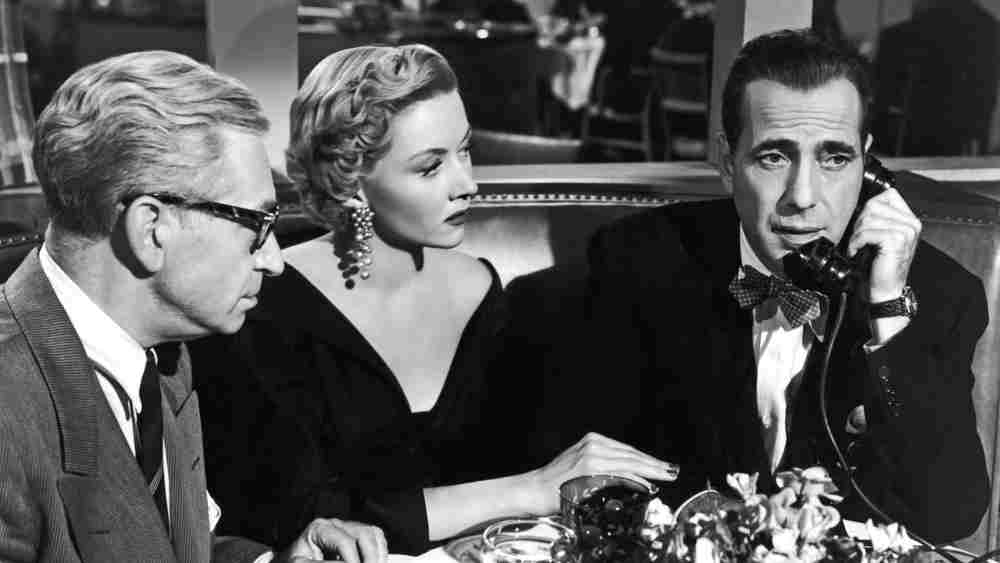
Nicholas Ray’s dark noir drama is a story of self-obsession, loneliness, and alienation. Humphrey Bogart plays Dix Steele, an alcoholic Hollywood screenwriter. One night, he meets a coat-check girl who has read the book he’s supposed to adapt. Dix invites her home to talk about it and eventually sends her away. But the girl is murdered and Dix becomes the suspect. Though it sounds like an elemental crime story, In a Lonely Place gradually transforms into a deft character study.
It’s a study of the volatile and isolated Dix. Ray’s direction has a heightened sense of style which is apparent in the way he sets the mood for suspense sequences. The black-and-white cinematography alongside the use of lighting adds great intensity to the proceedings. Eventually, In a Lonely Place, like many post-war film noirs, withholds a strong subtext of a war veteran struggling to adapt to society.
6. Out of the Past (1947)
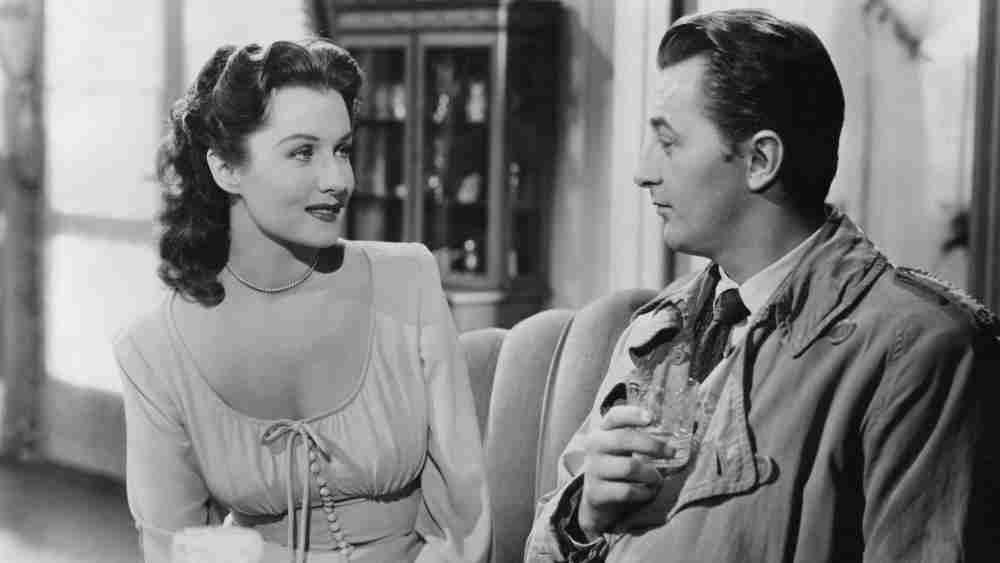
Similar to Siodmak’s The Killers, Jacques Tourneur’s classic film noir opens near the end, and largely unfolds in flashback. Robert Mitchum’s protagonist lives in a small town running a gas station under an alias. But there’s an inevitable sense of doom as the man knows that the past will catch up with him soon. Thrown into the narrative mix are the archetypal femme fatale, and an elegantly dressed ruthless mobster.
What’s interesting about Out of the Past is its visual style which doesn’t employ a lot of high-contrast cinematography. Still, Tourneur finds distinct ways to obscure character appearance and intensify atmospheric tone to deliver suspense. There’s also ferocious sarcasm in the dialogues. Particularly when delivered with a perfect attitude and style, the experience is thoroughly engrossing.
Anxiety, fear, double identities, and mistaken identities are recurrent themes in Tourneur’s oeuvre. The French master filmmaker was known for his low-budget horror films in the 1940s (Cat People, I Walked With a Zombie, etc). His transition to film noir and Westerns in some manner expanded the stylistic limits of those genres.
5. Laura (1944)
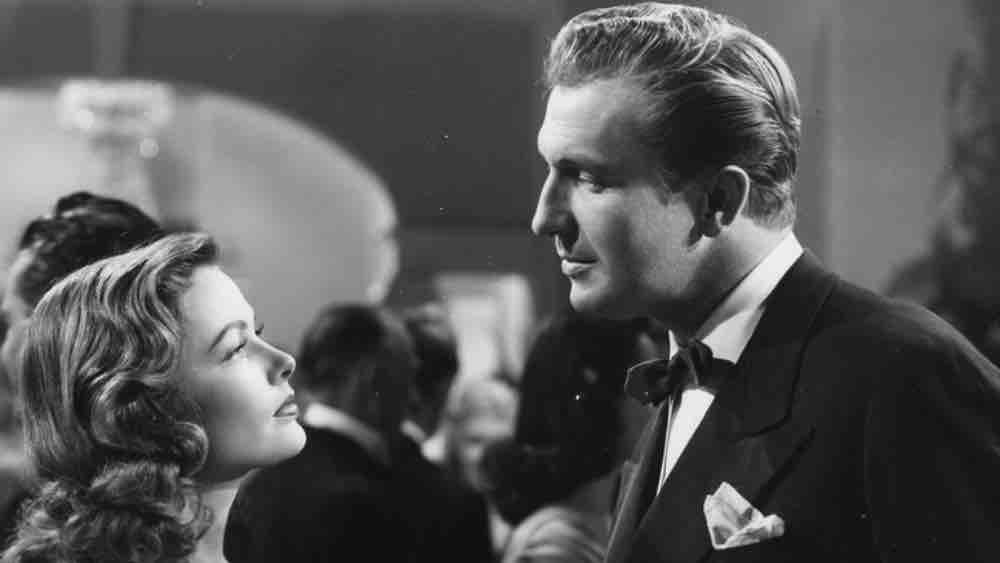
No one can deny the seductive and powerful visual style of Otto Preminger’s Laura. Based on author Vera Caspary’s 1942 novel of the same name, the narrative is a bewitching portrait of the titular character. However, like a typical film noir, it opens with a murder investigation. Dana Andrews plays a detective who interrogates the suspects of Laura’s alleged killer. He is also smitten by Laura’s portrait hanging in her apartment. But an unexpected arrival completely takes the detective by surprise.
Preminger’s noirs are well-regarded for their palette of deep shadows and brightness. His rich visual texturing and precise staging greatly intensifies the emotional dimensions of the narrative. Gene Tierney is exemplary in the eponymous role. Her character subtly subverts the femme fatale noir trope. Laura isn’t shown as a wicked woman with a predilection for manipulation and power. The focus, rather, is on the men’s obsessive perception of her.
4. Sweet Smell of Success (1957)
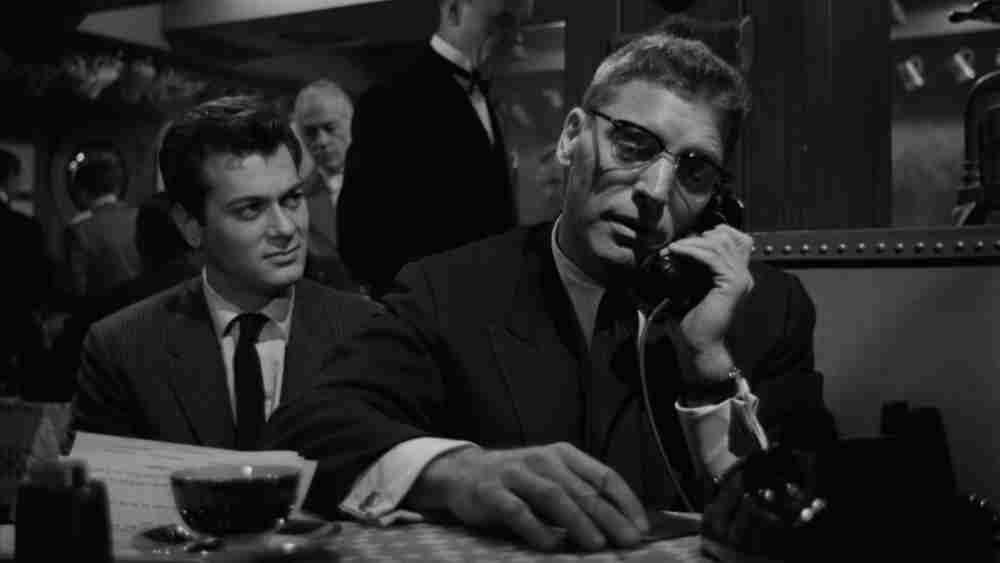
Alexander Mackendrick’s classic film noir is an acerbic examination of power and the American Dream. The story is not set in the criminal underworld but in exploitative press agents and columnists. Burt Lancaster plays J.J. Hunsecker, a rich, powerful columnist in New York City. His right-hand man is Sidney Falco (Tony Curtis), a desperately ambitious and young press agent. The two unscrupulous yet incredibly smart men make some choices to promote their personal cause.
Sweet Smell of Success was based on Ernest Lehman’s novella. A real-life newspaper columnist and radio commentator Walter Winchell inspired Burt Lancaster’s character. The narrative is imbued with a vibrant and fascinating atmosphere. From chic nightclubs to elegant hotels, we see people desperately trying to climb the social ladder. The biggest strength of Sweet Smell of Success is nevertheless the performances and the brilliant punch lines.
3. The Big Sleep (1946)
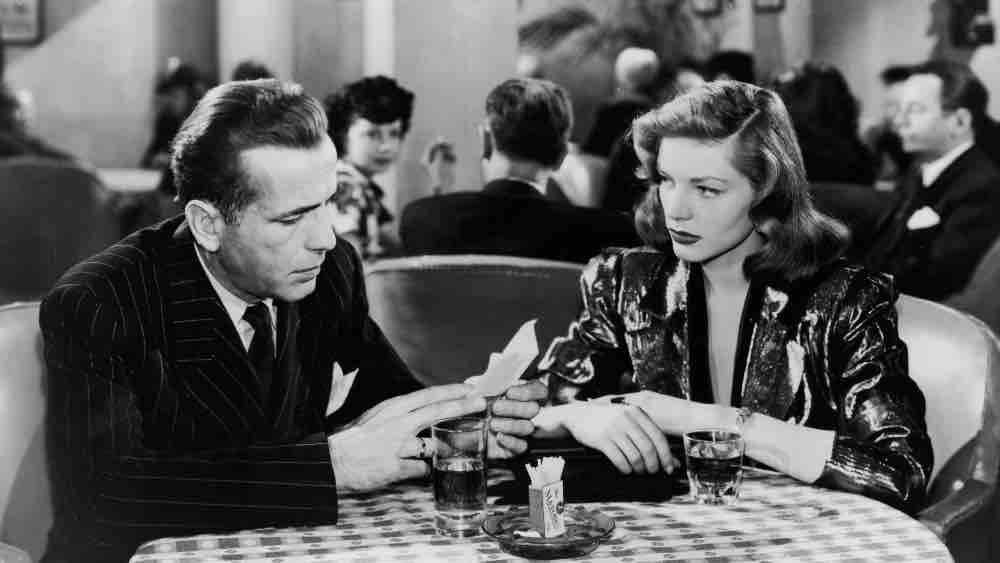
Howard Hawks’ The Big Sleep is based on Raymond Chandler’s popular 1939 detective fiction of the same name. Humphrey Bogart plays Philip Marlowe who goes around Los Angeles to investigate a convoluted black-mailing scheme that involves an old millionaire’s family. The Big Sleep is best known for three things: Bogart and Lauren Bacall’s irresistible charm, Hawks’ sordid and decaying imagery of Los Angeles, and an incomprehensible plot structure. In fact, the original cut of The Big Sleep is said to be superior and tells a complete story. The re-edited version makes the structure very puzzling and a lot of details remain hazy till the end.
Yet The Big Sheep unfolds at a brilliant pace and is full of lively banter that it’s easy to overlook its baffling aspects. Chandler’s novel itself was more fascinating by the process of investigation than the final answer to the mystery. Similarly, the visual and emotional impact built by Hawks and his cast makes this a key work in the film noir canon.
2. Touch of Evil (1958)
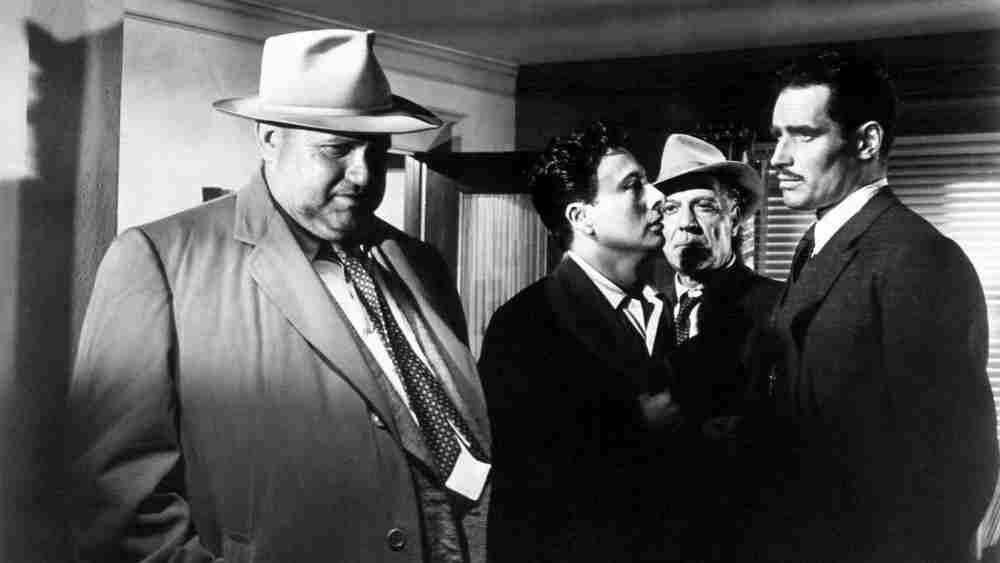
One of the best film noirs, Touch of Evil is considered to be the last great work of the classic era. It’s also declared the greatest Orson Welles movie after Citizen Kane (1941). Loosely based on a novel called Badge of Evil, this was another Welles feature that suffered from studio meddling. Yet right from the opening crane shot, the stylistic noir flourishes bestow an enriching movie experience.
Set on the US-Mexican border, Touch of Evil has a simple story. The film centers around a complicated power struggle between the righteous Mexican narcotics officer Vargas and corrupt police chief Hank Quinlan. While Charlton Heston plays the hero, Welles’ Quinlan is the perfect personification of evil. Similar to Ride the Pink Horse, Touch of Evil is a border town-set noir that gradually crafts a complex tale of morality and race. However, the narrative set-up here is more explosive and full of eye-catching performances. Welles’ cinematic touches are very unique. And his visual strategies only turned more potent and influential within the film noir tradition.
1. Double Indemnity (1944)

Billy Wilder’s Double Indemnity is the quintessential film noir. Everything from its first-person narration and characters to the imagery and scenarios epitomizes what noir films are all about. Based on James Cain’s novel, this is a cynical story about murder and personal corruption. Fred MacMurray plays Walter Neff, an insurance investigator. He falls for the icy Phyllis Dietrichson (Barbara Stanwyck). Fatigued by the daily routine, and the obsession for Phyllis drives Neff to help her kill her husband.
Double Indemnity established Austrian-born Billy Wilder as an A-list filmmaker in Hollywood. Many felt the sleazy Cain novel could never be adapted to fit the constraints of Hay’s Production Code. Yet Wilder artfully constructs his tale of lust and murder. It’s also interesting to note that Wilder’s co-writer was the popular hardboiled fiction author Raymond Chandler. The stylized dialogue that’s laced with sensuality and sarcasm elevates the source material.
Cinematographer John Seitz and Wilder worked closely to establish the look of the film. From the Venetian blinds to the subtle smoke effects, and long silent streets, the imagery was a great influence on the subsequent works of film noir genre.
Conclusion
There we are! These are some of the best film noirs every cinephile should see. Noir elements have left a mark on the cinematic medium globally. It broke the idea that film noir is a distinctly American phenomenon. Jean-Luc Godard’s groundbreaking works Breathless (1960) and Alphaville (1965) were homage to noir films. Jean-Pierre Melville, Wim Wenders, and Jacques Audiard are some of the other European filmmakers who modeled their best works around noir narrative elements.
In America, the neo-noir boom continues to offer phenomenal cinema. From Blade Runner (1982), Blood Simple (1984) to L.A. Confidential (1997), Drive (2011), and Inherent Vice (2014), noir genre tropes are embellished and reconstructed in multiple ways. In fact, the noir elements will continue to have a lasting impact in the coming decades too.
